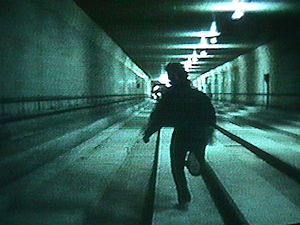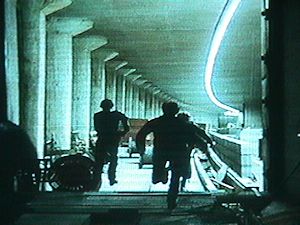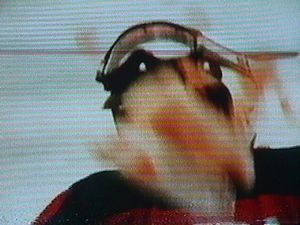memory
reenactment
déjà-vu
mnemonics
1966 The Art of Memory
1998 "The Hospitality of Presence: Problems of Otherness in Husserl's Phenomenology"
2001.12.04 "a mimetic "condensation" of another place and time"
He inferred that persons desiring to train this faculty (of memory) must select places and form mental images of the things they wish to remember and store those images in the places, so that the order of the places will preserve the order of the things, and the images of the things will denote the things themselves, and we shall employ the places and images respectively as a wex writing-tablet and the letters written on it
Cicero, De oratore, II, ixxxvi, 351-5 as quoted in Francis A. Yates, The Art of Memory (Chicago: The University of Chicago Press, 1966), p, 2.
It is not difficult to get hold of the general principles of the mnemonic. The first step was to imprint on the memory a series of loci or places. The commonest, though not the only, type of mnemonic place system used was the architectural type. The clearest description of the process is that given by Quintilian. In order to form a series of places in memory, he says, a building is to be remembered, as spacious and varied a one as possible, the forecourt, the living room, bedrooms, and parlours, not omitting statues and other ornaments with which the rooms are decorated.
. . .
We have to think of the ancient orator as moving in imagination through his memory building whilst he is making his speech, drawing from the memorized places the images he has placed in the building.
Francis A. Yates, The Art of Memory (Chicago: The University of Chicago Press, 1966), p, 3.
We require therefore places, either real or imaginary, and images or simulacra which must be invented. Images are as words by which we note the things we have to learn, so that as Cicero says, 'we use places as wax and images as letters'. It will be as well to quote his actual words:--'One must employ a large number of places which must be well-lighted, clearly set out in order, at moderate intervals apart, and images which are active, which are sharply defined, unusual, and which have the power of speedily encountering and penetrating the mind.
Quintilian, Institutio oratoria, XI, ii, 17-22 as quoted in Francis A. Yates, The Art of Memory (Chicago: The University of Chicago Press, 1966), p, 22-3.
from The Limits of Interpretation
"To show examples of flexible criteria of resemblance, let me quote, not the most radical occult and Hermetic theories, but rather some instances of a very reasonable semiotic technique, the one recommended by the authors of the arts of memory. Those authors were neither Kabbalists nor sorcerers summoning spirits. They simply wanted to build systems for remembering a series of ideas, objects, or names through another series of names, objects, or images of objects. Other authors (Rossi 1960; Yates 1966) have studied and described the complex constructions of loci, that is, of real architectural, sculptural, and pictorial structures that those theorists built in order to provide a systematic plane of expression for the contents to be memorized, signified, and recalled. It is clear, however, that these mnemotechnic apparatuses were something more than a practical devise for remembering notions: it is not by chance or for decorative purposes that the systems of loci frequently assume the form of a Theater of the World or emulate cosmological models. They aim at representing an organic imago mundi, an image of a world which is the result of a divine textual strategy. Thus, to be semiotically efficient, they reproduce the presumed tangle of signatures on which the Universe as a significant Whole is based. As Ramus (1581) has remarked, memory is the shadow of the order (of the dispositio), and order is the syntax of the universe.
But even though an ars memoriae was conceived as a mere practical devise, it had in any case to find recognizable links between a given image and the thing to be evoked. In order to establish such a relationship it was advisable to follow the same criteria that held for the interpretation of cosmic analogies. In this sense these artes tell us something about various socially and culturally established semiotic rules."
Umberto Eco, The Limits of Interpretation (1990), p. 25.
| |
The City of Collective Memory
Piranesi also borrowed the devices of Baroque scenographers, heightening the impact of his fantastical compositions of Rome by twisting and turning their viewpoints, creating a confused montage of fragments and spaces, of exaggerated proportions and depth. If Greek architecture was the epitome of purity and restraint, then Roman architecture, so Piranesi surmised, had been erected by plunderers and despoilers, and its compositional forms were not only eroded by time but compromised by choice. Roman ruins were exceptions to the ideals of purity, existing beyond any order that classicists might impose. Their mysterious allure resided instead within irrational and archaic realms. So Piranesi, a bricoleur in search of new orders and new inventions, turned away from those who poked around for the origins of architecture among its ornaments and stones and reached beyond the contemporary zeal for restoration. He moved instead into an arbitrary, utopian, and entirely imaginary sphere of subjective experience. Fantasy holds an essential role in any "analogous city" view, for fantasy is the mediator between an archeologist's mind bent on exploring roots and remnants of antiquity and a creative imagination that quotes and remembers only arbitrary and unrelated fragments and traces. Through incongruous recombinations and imaginary superimpositions, Piranesi diverted architectural symbols from their original meaning. He played an enigmatic game of architectural writing in which reality and the imaginary are confused.
M. Christian Boyer, The City of Collective Memory : its historical imagry and architectural entertainments (Cambridge, MA: The MIT Press, 1994), pp. 176-8.
1998.09.17 10:55
fact check and some truth
On Tuesday, I spoke (on the phone) with Susan S., the PR rep of Venturi Scott Brown & Assoc. She did not know that the big BASCO sign was now gone, and she pretty much assumed Mr. Venturi did not know either. Although this was our first time speaking together, we had a very animated conversation about "commercial" architecture and its fate as something fleeting. Recognition of this phenomenon may be especially easy for baby boomers to see because so many places of memories from the 1950s and 1960s are simply no longer there.
I specifically called to find out if the big BASCO sign's second design--where the red letters were painted yellow and then covered with an overall pattern spelling the word BEST--upon the meager of Basco and Best was also a Venturi office design. It was.
Last night, I re-read what Venturi, Scott Brown and Izenour said about Las Vegas signs in Learning from Las Vegas, and it is as if they unwittingly predicted the fate of their own big sign.
1999.05.13 09:02
semiotecture
Eisenman concludes (in 1984):
Therefore, to propose the end of the beginning and the end of the end is to propose an end of beginnings and ends of value- to propose another "timeless" space of invention. It is a "timeless" space in the present without a determining relation to an ideal future or an ideal past. Architecture in the present is seen as a process of inventing an artificial past and a futureless present. It remembers a no-longer future." [end]
B concludes (in 1999):
I think this means that there might be a thing or issue called- architectural "literacy" -about which the reading of buildings consists of a knowledge system of material culture. That is why, architectural and culturally, I think it is significant to focus on the mundane buildings- in order to read the built environment. Places like fast-food restaurants, gas stations, powerplants, ports, industrial ruins, in opposition to what is considered "great Architecture" and great Architects.
Steve replies:
I think it is important to note the 15 year differential between the two about texts-opinions. Despite its erudition, Eisenman's text is very much also an attack on post-modern architectural design as well as propaganda for his own "brand" of design (at that time). It is somewhat ironic that brian receives an inspiration, a way of looking at today's built environment, from Eisenman's 1984 text that may indeed be exactly opposite to what Eisenman proposed 15 years ago. To more fully understand Eisenman's text it is necessary to know Tafuri's texts as compiled in The Sphere and the Labyrinth, particularly the notion of (classical) language being dead. Unfortunately, Tafuri's big example of dead classical language is/was Piranesi's Campo Marzio, and it is there that Tafuri is entirely wrong, which by extension undermines Eisenman's argument as well.
B, you are and have been looking to understand a design language that is almost entirely ignored by the design profession, and that is (I think) the greatest value of your work. At this point, be careful not to confuse your own issues with other texts that may or may not apply. Your own originally is probably your greatest asset.
The above was more of a specific reply, and for a more general reply to Eisenman's end-beginning-end text see xxx.htm--there you will find a "design of a house 1983" accompanied by some real schizophrenic text written by my brother (which is coincidentally a perfect (non)reply to Eisenman), plus a small detail of my former living room. The living room photo is merely incidental, but the plan and the text are there precisely to be "read" with regard to classic(al) "literacy" (or the end-beginning-end thereof).
M wrote:
In the opening pages of Civilisation & Its Discontents, Freud makes some interesting remarks about the nature of memory and psychic structure in a metaphorical passage about the architectural history of Rome. Malcolm Bowie once memorably suggested that this could provide the basis for thinking Freud as town planner!
another general Steve reply:
See xxx.htm and follow the "eros and death" link to encounter another "metaphorical passage about the architectural history of Rome" courtesy Piranesi (who knew exactly what "classic" architectural literacy was all about, not to mention his knowledge of the dead language of Latin).
| |
1999.05.24 22:25
interview 2.1a
I wish I could remember what my first architecture thought was. The best my memory banks can come up with was when I was about three years old my mother demonstrated a particularly imaginative (re)use of cardboard packaging items turning them into a house.It was a great mind spark because I suddenly saw that things could represent something other than what they were. That may have been my first jump start out of stupidity.
1999.06.07 23:49
the more real Piranesi-effect
The more real 'Piranesi-effect' of our time is the continual confusion and misinterpretation of Piranesi's Ichnographia Campus Martius by architects, architectural historians, and architectural theorists over the last forty-three years.
Beginning with major factual errors within Vicenzo Fasolo's "The CAMPOMARZIO of G.B. Piranesi," which first appeared in Quaderni dell'Instituto di Storia dell'Architettura, n.15, 1956, Piranesi's large plan of the Campo Marzio has received one misinterpretation after another.
After Fasolo, the Campo Marzio's greatest misinterpreter is Manfredo Tafuri, who wrote eloquently, albeit incorrectly, about the Campo Marzio in both Architecture and Utopia - Design and Capitalist Development, 1976 and The Sphere and the Labyrinth - Avant-Gardes and Architecture from Piranesi to the 1970s, 1987. Outside of the strictly historical accounts of Piranesi's Campo Marzio printing by John Wilton-Ely in The Mind and Art of Giovanni Battista Piranesi, 1978 and by Jonathan Scott in Piranesi, 1975, Tafuri's texts were the only written interpretations of the Campo Marzio readily available to architectural thinkers throughout most of the [20th] century's last quarter. Tafuri's well respected position as the Director of the Department of History of Architecture at the Instituto Universitario di Architettura in Venice led to an unquestioned acceptance of Tafuri's words regarding the Campo Marzio.
Taking Tafuri's false lead, a string of contemporary architects and/or architectural theorists consistently paraphrase Tafuri's texts, thus further procreating subsequent generations of ill-bred Campo Marzio interpretations. The (architectural) authors and texts are:
Stanley Allen, "Piranesi's Campo Marzio: An Experimental Design" in Assemblage (Cambridge, MA: MIT Press Journals, December, 1989), pp. 71-109.
Jennifer Bloomer, Architecture and the text: the (s)crypts of Joyce and Piranesi (New Haven: Yale University Press, 1993).
Peter Eisenman, "Autonomy and the Avant-Garde" in Autonomy and Ideology: positioning the avant-garde in America (New York: Monacelli Press, 1997), pp. 70-9.
Alex Kreiger, "Between The Cursader's Jerusalem and Piranesi's Rome" in Form, Modernism, and History (Cambridge, MA: Harvard University Graduate School of Design, 1996), pp. 151-164.
Rafael Moneo, "Recent Architectural Paradigms and a Personal Alternative" in Harvard Design Magazine (Summer 1998).
Sanford Kwinter, "Can One Go Beyond Piranesi?" in Eleven Authors in Search of a Building (New York: The Monicelli Press, 1996).
Using the Kwinter quotation, "the effect of unforeseeable complexity that arises from multiple interfering structures blindly pursuing their own clockwork logic," as a case in point, one only has to compare it to the following Tafuri quotation, "The clash of the formal organisms, immersed in a sea of formal fragments, dissolves even the remotest memory of the city as a place of Form," and "the whole organism seems to be a clockwork mechanism," to see that Tafuri's misinterpretations of the Campo Marzio still guide those that do not know better.
Perhaps the Kwinter quotation really defines the 'Tafuri misinterpretation of Piranesi-effect.'
| |
1999.11.07 20:43
Encyclopedia Ichnographica
As it stands now, my ongoing investigation and redrawing of the Ichnographia has led to the 'discovery' of a whole new aspect of Piranesi's work that so far no one else has found, namely that the large plan of the Campo Marzio is a readable narrative of Ancient Rome's political and architectural history--but in order to grasp this delineated 'text' one must 'read' in unison the individual plans, the plans in relationship to each other, the plans in relation to where the actual buildings really were, and (this is perhaps the most important) the Latin labels Piranesi gives to each plan.
1999.12.30 20:18
Mother knows best
My mother speaks German and only has a working knowledge of the English language, and if there's something that doesn't seem to effect her directly, it's not really going to register--kind of like a convenient memory.
2000.10.05 21:21
Re: architectural photography
I think architectural photography is extremely valuable when the architecture in photographs no longer exists but in photographs.
Just over three years ago I went to photograph Venturi & Rauch's big BASCO 'sign' building. The building was then derelict, and I took many 'unflattering' snapshots, e.g., lots of empty beer bottles and a plump vinyl lounge chair providing an interesting domestic tableau just behind the big 'A'. Alas the film did not develop at all, and hence no photographic record and just a memory for me. Almost exactly a year later I returned to BASCO to take pictures again, however, the big letters were that time completely gone. I turned out to be the person informing Venturi's office of the loss.
The point is that 1) many buildings today change radically in short periods of time, therefore ALL photographic records (not just the flattering ones) are important items in understanding the 'life' of architecture most fully, and 2) a photograph of a building that once was but is no more is perhaps the easiest form of virtual architecture invented thus far.
ps
...I add that architectural imagery (photography, photocopy, digital records, etc.) today is very cheap, meaning the notion of capturing a building in the perfect 'light' is nothing more that creating a fetish, an ideal that is forever virtual and definitely not real. You might say that more than anything architectural photographs have patently deceived many viewers (architects/critics) into believing the photograph is the reality.
2000.11.13
memories of desire?
I wanted to rent Paris, Texas, but it was out, so I rented Spetters and Ulysses' Gaze.
In watching Spetters (14 years since I last did so) I have to report the mistakes I made in my last post about that film. What's funny is the types of mistakes my memory made.
The boys are all 20 years old, (not teenagers). The farmer father does not chase his son on a tractor, rather pulls the "whore of Babylon's" Chevy Impala (I was right about that) out of a roadside ditch that the farmer's son stupidly backed into. The 'puritanical', farmer father does routinely beat his son, however (and the son has a definite sado-masochistic streak to him -- he gets himself 'coiled up' in the 'sub-plot' within the under-construction subway).
 
Only two of the boys are amateur racers, while the farmer's son is an auto mechanic at the gas station.
And here's my favorite memory mistake: it is not extra long hot-dogs that are the most popular item at the "whore's" luncheon business, rather it is 'croquettes' (or something spelled like that) which, unknown to the customers, are made of canned dog food. [Obviously serving the question, "is real fast food actually any better?"]
Overall, I was correct that Spetters is a nimiety of vehicles. It's like Two for the Road on multiple steroids.
After now being well re-acquainted with both films, what's really interesting is the difference the 1970s made. The change in 'style' from Two for the Road (1967) to Spetters (1980) is very noticeable, and the fact that both films are 'vehicular' heightens the changes. There is one very weird coincidence between the two films, however. The station wagon in Spetters is also driven by a family (husband, wife, a boy and a girl), and the hero of the film has his paralyzing motorcycle accident because the husband in the station wagon throws a bag of orange peels out the car window while he's driving. Perhaps it really isn't odd that the station wagon and the nuclear family come to represent conformity in both films, but they also come to represent the 'death' of the free (wheeling) spirit.
 
Alas, I finished watching Spetters and then began to watch Ulysses' Gaze (which I've never seen before but have the soundtrack of for two years now), and the pace went from 75 MPH to 5 MPH. I haven't finished watching the film yet, but it looks like one might be able to analyze the 'vehicles' in it as
well. But it won't surprise me if the notion of "film" itself turns out to be Ulysses' Gaze's primary vehicle.
|